Join Our List
 |
| Out & About | |
You can find OES at these upcoming events:
September 11:
September 21-22:
Focus on Green Community Tent at
|
| Events & Resources
|
(Renewable Energy & Sustainable Development BLOG)
|
|
|
Green Roofs - A great strategy for keeping buildings cool. Temperatures on this DC roof have been as much as 43.5 degrees less than neighboring convetional black roofs. For more information visit www.asla.org/greenroof. 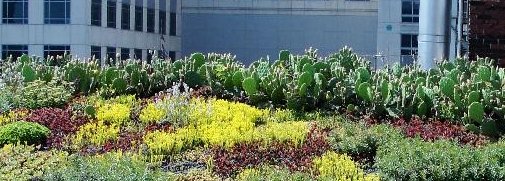 | |
|
Like summer, sustainability is a hot topic! From inventorying greenhouse gas (GHG) emissions to managing the County's Energy Efficiency and Conservation Block Grant, OES is moving full steam ahead to achieve its mission of advancing practical solutions for protecting the environment, conserving energy and living sustainably in Frederick County, Maryland.
Earlier this summer, I toured green roofs in DC with Commissioner Gray, like the one pictured above. Fortunately, green roof temperatures are much cooler than conventional black roofs. Most people tout green roofs for their storm water management benefits; on that particular afternoon, I was celebrating their cooling potential! Did you know that Frederick County is constructing its first green roof right now? The Catoctin Creek Park and Nature Center scheduled to open this year features a green roof with access for viewing. Check out progress on the building. Another exciting development is our Frederick County Green Homes Challenge and Certification Program. The Green Homes Challenge, to be launched this fall, will offer residents ways to save energy and money, green their lifestyle, and incorporate renewable energy at home. Residents can achieve the Power Saver, Green Living Leader, and Sustainable Star certification and gain recognition for their sustainability achievements. Look for more on the Green Homes Challenge at In the Streets and the Great Frederick Fair in September.
This month, two exciting projects are going to the Board of County Commissioners. On August 24th, Kelli Goetz presents the Frederick County GHG Inventory Report and on the 26th, I present the Sustainable Action Plan for County Operations, developed by the 32-member Sustainable Action Team (comprised of employees representing 23 County divisions and independent agencies).
Check the OES web page for links to the publications - our new URL www.SustainableFrederickCounty.org will get you there! If our reports and publications don't provide enough summer reading material, my suggestion is Thomas Friedman's Hot, Flat and Crowded: Why We Need a Green Revolution - And How it Can Renew America. Mr. Friedman is a foreign affairs columnist for the New York Times and while I haven't completed the book, I think it's a hot, summer read for anyone interested in sustainability.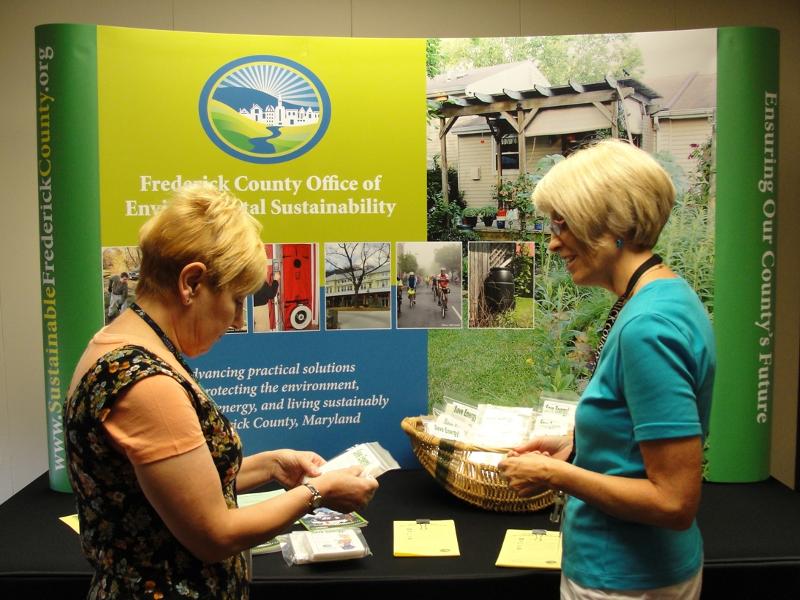
Hilari Varnadore
Director, OES
PS. OES has a brand new beautiful display. Look for it at In the Street on September 11, or in the Focus on Green Community Tent on September 21-22 at The Great Frederick Fair! |
| PRESENTATION: Comprehensive Energy Plan Delivered to the County Commissioners | 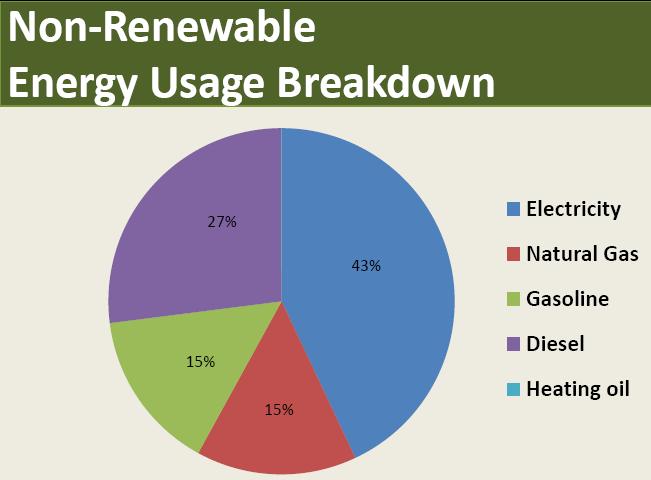 On June 22nd, the Management Services Division (MSD) presented a Draft Comprehensive Energy Plan to the Board of County Commissioners. The plan proposes a strategy for reducing non-renewable energy consumption in County buildings, facilities, and vehicle fleet by 50% over 15 years. A combination of conservation initiatives and investment in renewable energy are proposed to reach -- and exceed -- the 50% goal. The Sustainability Commission reviewed the plan at their July meeting and provided comment to MSD. The next step is for staff to review comments and take the plan back to the Board for their final review and acceptance. The plan is available for review on our publications page or you can view MSD's presentation to the BOCC on June 22, 2010. On June 22nd, the Management Services Division (MSD) presented a Draft Comprehensive Energy Plan to the Board of County Commissioners. The plan proposes a strategy for reducing non-renewable energy consumption in County buildings, facilities, and vehicle fleet by 50% over 15 years. A combination of conservation initiatives and investment in renewable energy are proposed to reach -- and exceed -- the 50% goal. The Sustainability Commission reviewed the plan at their July meeting and provided comment to MSD. The next step is for staff to review comments and take the plan back to the Board for their final review and acceptance. The plan is available for review on our publications page or you can view MSD's presentation to the BOCC on June 22, 2010.
|
| THE CARBON CORNER: What is the Difference Between Global Warming and Climate Change? |
NASA's comparison of average mean tempertures in 1885 and 2006 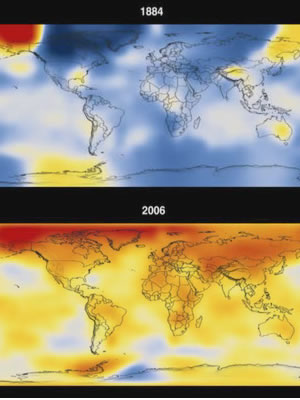 | Depending on who is talking, there can be an enormous difference or no difference at all. A lot of people, including many journalists who write about the topic, use the two terms interchangeably. When reporters first began talking about how humans seemed to be doing things that result in heating up the planet, the term they usually used was global warming. That's because the basic effect of greenhouse gases like carbon dioxide is to do exactly that. They trap more and more of the Sun's energy and drive the average temperature of the planet upward.
But there is more to it than that. Average temperature is global, while climate is local and involves not only average temperature, but also other factors that can vary, such as precipitation, wind, and extreme weather events. Scientists have learned that raising the Earth's temperature most likely will change many of these factors. So while global warming is what's causing it, what most people are going to notice is not necessarily warming but rather an overall change in climate. The bottom line is that while global warming is not wrong, climate change more accurately describes what is actually happening.
|
| INCENTIVES: Making Efficiency & Renewable Energy Affordable |
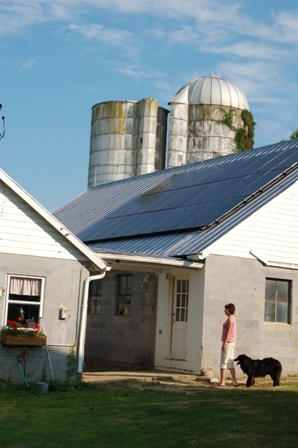 "If it wasn't for the upfront cost, I'd love to have an energy efficient home and be able to install renewable energy systems on my property." "If it wasn't for the upfront cost, I'd love to have an energy efficient home and be able to install renewable energy systems on my property."
If that sounds like you, read this summary to learn about how a variety of grants, incentives, tax credits and rebates can make energy efficiency and green power more affordable than you might think! From no-cost audits to renewable energy and bio-heating oil tax credits, residents can save thousands of dollars making their homes more comfortable and energy efficient. For assistance making energy efficiency and renewable energy decisions, contact Lisa Orr, Sustainability Program Coordinator in the Office of Environmental Sustainability, at [email protected] or 301.600.6864.
|
| UPDATE: Clean Energy Loan Program (CELP) |
 Our Spring 2010 article about the CELP (also known as PACE - Property Assessed Clean Energy) generated a lot of interest among homeowners and businesses looking for financing options for major energy efficiency retrofit or renewable energy systems. This Maryland Clean Energy Center initiative, as well as PACE initiatives nationwide, have hit some roadblocks. The Federal Housing Finance Agency (FHFA) and the Office of the Comptroller of the Currency (OCC) recently issued statements blocking PACE pilot programs primarily due to the senior status of PACE liens. Because of FHFA's oversight of Fannie Mae and Freddie Mac, and OCC's influence over banks, the statements brought existing PACE programs to a halt and froze the ability of communities to launch PACE programs already under development nationwide.
To learn more about this quagmire and encourage Congress to take action, visit PaceNow.org. For a basic overview of PACE or the CELP works, view this slide show. |
| COMMISSION NEWS: McKalip-Thompson Appointed | 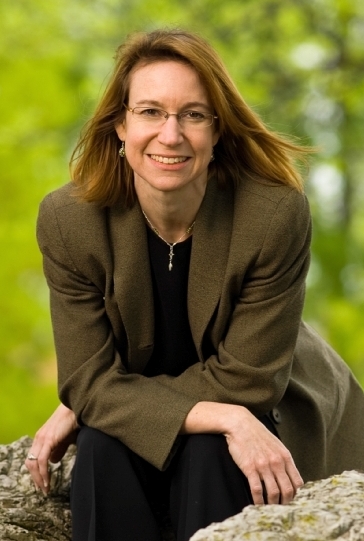 Catherine McKalip-Thompson, Sustainabile Development Manager for Bechtel Systems and Infrastructure (a division of Bechtel Group, Inc.) is the newest appointee to the 13 Member Sustainability Commission. Catherine provides strategic direction, education and tools for the business unit to fulfill Bechtel policy on sustainable development. Catherine is the Bechtel liaison to the U.S. Green Building Council and is a LEED� Accredited Professional. Catherine McKalip-Thompson, Sustainabile Development Manager for Bechtel Systems and Infrastructure (a division of Bechtel Group, Inc.) is the newest appointee to the 13 Member Sustainability Commission. Catherine provides strategic direction, education and tools for the business unit to fulfill Bechtel policy on sustainable development. Catherine is the Bechtel liaison to the U.S. Green Building Council and is a LEED� Accredited Professional.
The Commission meets on the 3rd Wednesday of the month at 3:00 p.m. in the 3rd floor meeting room in Winchester Hall. All meetings are open to the public. Join them for the discussion and provide input on how you believe they can accomplish their goals. NOTE: There will be no August 2010 meeting.
For more information about the Commission, click here. |
| TRAINING: $1,050 Solar Training Opportunity forJust $50 | 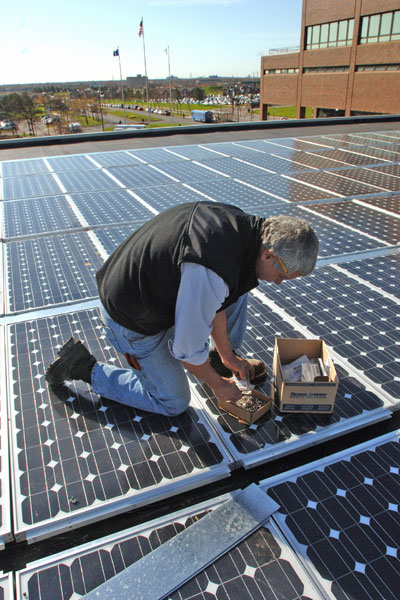 If you are interested in learning about Solar Photovoltaics (PV), here is a deal that's too good to pass up! Due to a renewable energy training grant won by the State of Maryland, the Independent Electrical Contractors (IEC Chesapeake) will be offering its six class North American Board of Certified Energy Practitioners (NABCEP) PV Entry Level training course for just $50 to Maryland residents only (a savings of $1,000!). Class dates: August 17, 19, 24, 26, 31 and Sept 2; Hours: 3:00 pm - 6:00 pm each day; For more information or to register, contact Dawn Fletcher at IEC Chesapeake directly at (301) 621-9545 ext. 104. If you are interested in learning about Solar Photovoltaics (PV), here is a deal that's too good to pass up! Due to a renewable energy training grant won by the State of Maryland, the Independent Electrical Contractors (IEC Chesapeake) will be offering its six class North American Board of Certified Energy Practitioners (NABCEP) PV Entry Level training course for just $50 to Maryland residents only (a savings of $1,000!). Class dates: August 17, 19, 24, 26, 31 and Sept 2; Hours: 3:00 pm - 6:00 pm each day; For more information or to register, contact Dawn Fletcher at IEC Chesapeake directly at (301) 621-9545 ext. 104.
Back to Top |
| MYTHBUSTERS: CFL Bulbs Release Dangerous Amounts of Mercury When Broken | 

One CFL contains a hundred times less mercury than is found in a single dental amalgam filling or old-style glass thermometer, according to the U.S. Environmental Protection Agency (EPA). By requiring less energy, CFLs will actually cut down on mercury pollution produced by coal burning which is a much greater threat to our health and environment. Even though incandescent bulbs don't contain any mercury, the increased electricity production they require compared to CFLs introduces more of it into the atmosphere. A broken CFL can be cleaned up by an average person as long as done so with caution; a professional cleaning company is not necessary. EPA recommends that (1) you immediately open windows to reduce mercury concentrations inside your home; (2) you do not touch the spilled mercury; (3) you clean up the broken CFL glass carefully and immediately (but not with your hands or a vacuum cleaner), and (4) you wipe the affected area with a paper towel to remove all glass fragments and mercury. EPA further recommends that you place the paper towel and glass fragments in a sealed plastic bag. Broken CFLs can be disposed on on Frederick County's two Hazardous Household Waste Days each year. The next one is October 23, 8am - noon, at the Public Safety Training Facility at 8349 reich's Ford Road, just before the entrance to the landfill. Any expired CFLs can be recycled at any Home Depot store through their national Eco Options initiative. For more information, read this EnergyStar Fact Sheet. (Sources: Maryland Energy Administration, TreeHugger.com)
Have you heard a myth or urban legend related to sustainability and the environment that you would like resolved? Send it to [email protected] and we'll get to the bottom of it!
|
| TOP PICKS: Online Tips & Resources for Sustainability | 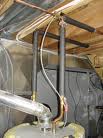 For Energy Conservation: For Energy Conservation:
Insulating the pipes leading from your hot water heater is a great energy saver. It is a simple low-cost ($20) do-it-yourself project that can save energy and money 365 days a year. Let Passionate Pat explain why this is so important and show you exactly how to do it in this 10 minute video.
For Kids: 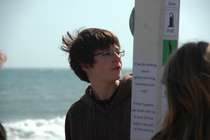
Young Voices on Climate Change is a film series featuring young people who are making a difference! They are shrinking the carbon footprint of their homes, schools and communities. You, too, can do something about global warming! As Alec Loorz says, "Kids Have Power." Frederick County author and illustrator, Lynne Cherry, is the originator, producer and director of the Young Voices on Climate Change films. She is well-known for her popular children's books especially her rain forest classic, The Great Kapok Tree and her environmental history A River Ran Wild.
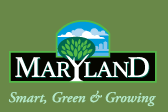 Help build a smarter, greener, more sustainable Maryland by putting proactive environmental practices to work right in your own organization. The Maryland Green Registry is a voluntary, self-certification program offering tips and resources to help organizations set and meet their own goals on the path to sustainability. Join the list of organizations working toward a Sustainable Maryland.
|
|
|
The Frederick County Office of Environmental Sustainability advances practical solutions for protecting the environment, conserving energy, and living sustainably in Frederick County.
|
|
|